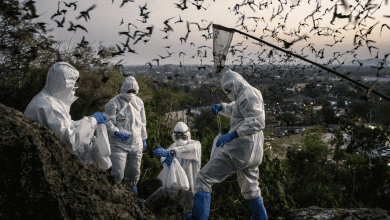
At least one person in Texas has been diagnosed with bird flu after having contact with dairy cows presumed to be infected, state officials said on Monday.
The announcement adds a worrying dimension to an outbreak that has affected millions of birds and sea mammals worldwide and, most recently, cows in the United States, according to New York Times.
The patient’s primary symptom was conjunctivitis; the individual is being treated with an antiviral drug and is recovering, according to the Centers for Disease Control and Prevention.
The Department of Agriculture announced the first cases in dairy herds in Texas and Kansas last week, and a few days later, in an additional herd in Michigan. Preliminary testing suggests that cows in New Mexico and Idaho may also be infected.
The virus has been identified as the same version of H5N1, an influenza subtype, that is circulating in North American birds.
“The C.D.C. is working with state health departments to monitor others who may have been in contact with infected birds and animals,” the agency said on Monday.
This marks the second case of H5N1 bird flu in the United States; the first occurred in 2022. Experts reassured that the risk to the public is minimal. “This is a rapidly evolving situation,” stated the U.S.D.A. in its recent announcement.
What is bird flu?
Bird flu, or avian influenza, encompasses flu viruses primarily found in birds. The current strain, H5N1, was initially detected in geese in China in 1996 and later in humans in Hong Kong in 1997. In 2020, a highly pathogenic variant of H5N1 emerged in Europe, rapidly spreading worldwide. The United States experienced its worst outbreak, affecting over 82 million farmed birds. Although sporadic cases have occurred globally, most resulted from prolonged, direct bird contact. Experts note that H5N1 has not yet evolved to efficiently spread among humans.
How did cows get bird flu?
Cows were not thought to be a species at high risk.
“The fact that they are susceptible — the virus can replicate, can make them sick — that is something I wouldn’t have predicted,” said Richard Webby, an influenza virologist at St. Jude Children’s Research Hospital.
This year, sick cows were reported in Texas and New Mexico, alongside dead birds found on some farms. Lab tests confirmed bird flu in some cows. Experts suggest various ways the virus might have entered cattle. The primary route, they believe, involves infected wild birds contaminating the cows’ food or water with the virus shed in their feces and saliva. Additionally, other susceptible animals like cats and raccoons could have introduced the virus to dairy farms.
Although the virus is often fatal in birds, it appears to be causing relatively mild illness in cows.
“It’s not killing animals, and they seem to be recovering,” said Dr. Joe Armstrong, a veterinarian and cattle production expert at the University of Minnesota Extension. Last week, the U.S.D.A. said that there were no plans to “depopulate,” or kill, affected herds, which is the standard procedure when poultry flocks are infected with the virus.
The disease is primarily affecting older cows, which have developed symptoms that include a loss of appetite, a low-grade fever and a significant drop in milk production. The milk that the cows do produce is often “thick and discolored,” according to Texas officials. The virus has also been found in unpasteurized milk samples collected from sick cows.
How widespread is problem?
It’s unclear. As of last Friday, the U.S.D.A.’s National Veterinary Services Laboratory had confirmed bird flu infections in two herds in Texas, two herds in Kansas and one herd in Michigan.
Initial testing has suggested that additional herds in Texas, New Mexico and Idaho may also have the virus, but those findings have not yet been confirmed by the national laboratory. So far, the virus has been found only in dairy cows and not in beef cattle.
The movement of cattle between states could transport the virus to new locations. The affected dairy in Michigan had recently imported cows from an infected herd in Texas. When the cows were transported, the animals were not displaying any symptoms. The farm in Idaho had also recently imported cows from an affected state, Idaho officials said.
How is it spreading?
This question is still unanswered. It is possible that the infected cows are picking up the virus independently, especially if shared food or water sources have been contaminated.
Several scientists said that they would be surprised if there were not some degree of cow-to-cow transmission. “How else could it move so rapidly?” said Dr. Gregory Gray, an infectious disease epidemiologist at the University of Texas Medical Branch. If the virus can spread easily between cows, that could lead to larger, more sustained outbreaks. It would also give the virus more opportunities to adapt to its new mammalian hosts.
How will officials know if bird flu adapts to spread between people?
Analyzing the virus’s genetic sequence from infected birds, cows, and humans can reveal whether H5N1 has acquired mutations aiding its spread among humans. Scientists closely monitor infections in various animals, including cows, but the virus doesn’t appear efficient at human-to-human transmission. In 2012, researchers found H5N1 capable of airborne transmission among ferrets after acquiring five mutations. A sample from a Chilean with bird flu last year showed two mutations indicating adaptation to infect mammals.
However, experts note these mutations have been observed without further evolution for human-to-human transmission.
Related Topics :
Corona-virus vs. Wars …. A radical change is underway
How to protect yourself from Coronavirus (Covid-19)?
How to protect yourself from Coronavirus (Covid-19)?





